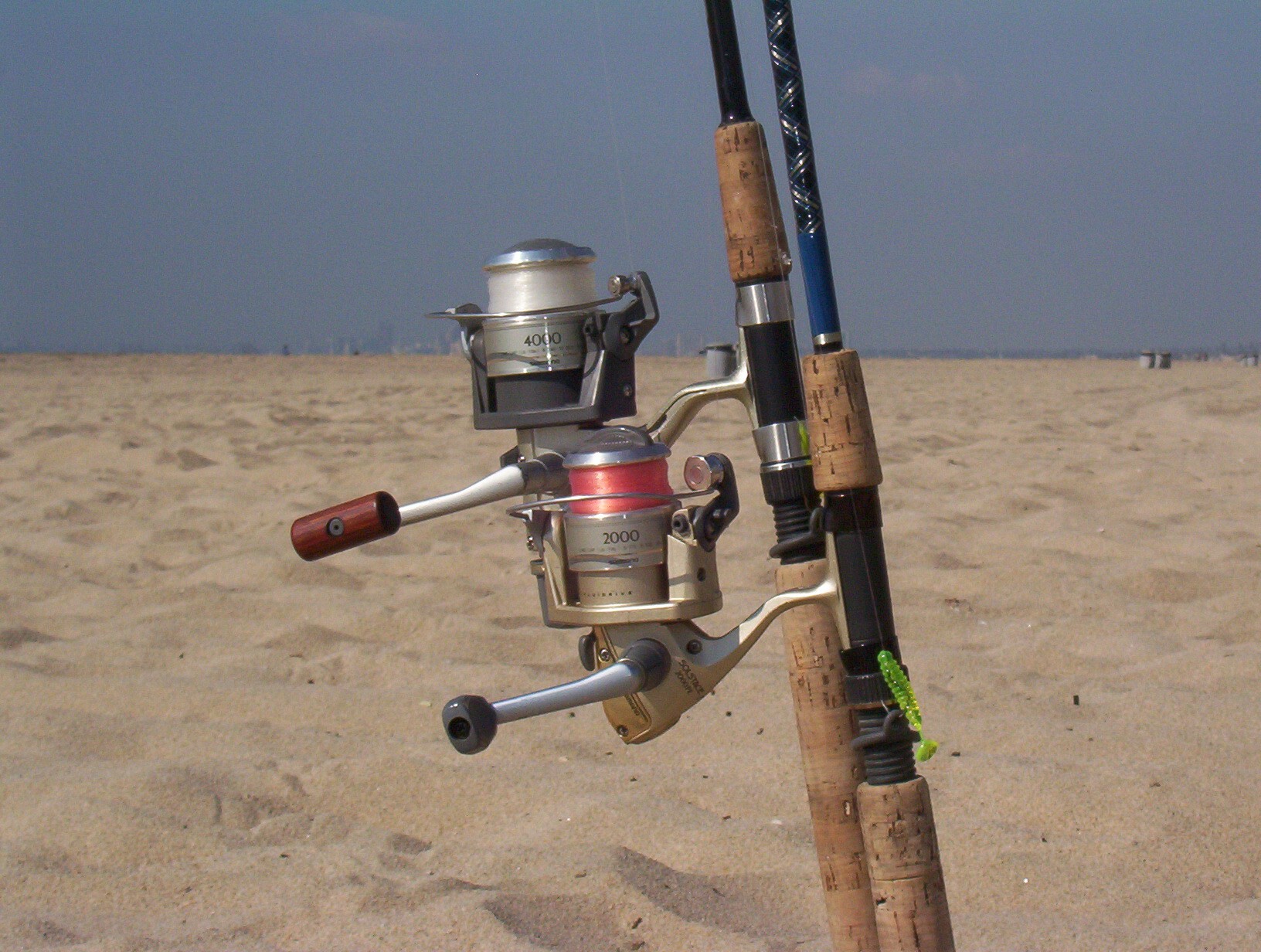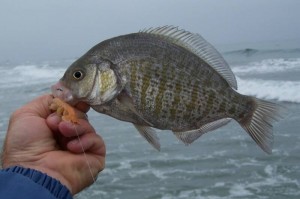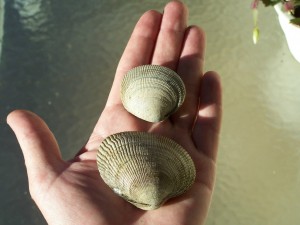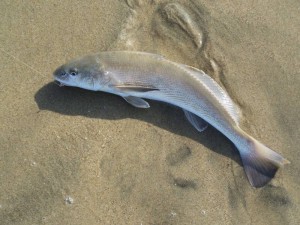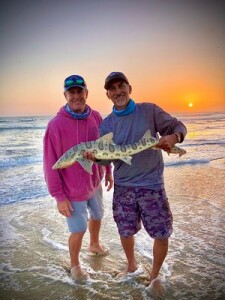Surf Fishing Be Prepared: Ten Tips Before You Hit The Beach
Nothing is worse than hitting the beach for a great surf fishing session and having your equipment let you down. By preparing a few important items before you reach the beach you’ll be guaranteed to have a much better chance of catching fish. Here are my top ten tips:
Start preparing the night before. Being well organized and properly prepared will ensure that your chances of catching fish will measurably improve. Start with your rod and reel. Check your reel for smooth operation (especially the drag, which is critical in maintaining control of the fish on light-line). Make sure your line is fresh and in good condition. Next, check your rod and make sure the reel is tight on the seat and that your guides are in good working condition.
Get your bait ready. If you’re using clams or mussel, shuck them and put them in small zip top bags before you go. You don’t want to be fiddling with a knife in the dark or when you could be catching fish. If you have live ghost shrimp put them in a small container of cool water. Place a frozen bottle in the water overnight and you will have lively, crisp shrimp in the morning. If you have collected sand or sidewinder crabs, flush them with cool salt water twice per day and keep them in a cool place until use. When it comes to grubs and artificial lures know in advance what you want to use. Don’t waste time fooling around with your bait at the beach.
Pre-tie leaders. Tie several lengths of leader with different sizes and types of hooks. In the surf I like to use hook sizes 1, 2 and 4 (depending on bait size) and a Owner Mosquito, Gamakatsu spit shot/drop shot or octopus hook. Use leader material appropriate for the areas you will fish and the target species. Organizing these on leader holders will keep them from getting tangled and make it easy to replace broken or knotted leaders.
Figure out what to wear in advance. You may like waders or a wet suit but here’s how I usually dress for the beach: In winter, I always try to stay dry. It seems the best time to fish is often at high tide so little wading is needed. I’ll wear sweats or jeans, old tennis shoes and socks. There’s a good chance your feet will get wet so an old pair of shoes is best. If you prefer you can wear calf length “mucking boots” just watch the surf so it doesn’t come over the top of your boot. On top, wear enough layers and you’ll be warm at sunrise and can peel down as the beach warms up. In spring, summer and fall I like to wade and fish at all tides. Shorts and trunks work great with bare feet or strap sandals (if you’re fishing on the rocks). A “T” shirt accompanied by a light jacket or windbreaker with pockets to hold your gear.
Get your camera and batteries ready. I like to use a plastic zip bag to carry my camera in. This helps keep the sand and salt off your equipment. Always clean your lens the night before with an appropriate lens cleaning paper or cloth to be sure there are no spots on the lens to obscure your pictures. Don’t forget to check your batteries tonight so you know your camera works tomorrow.
Organize and put your tackle in a tackle bag. Always be prepared but travel light. I like to use a small bag that straps around my waist or a tackle wallet that hangs from around my neck. Inside the bag I’ll have:
10 # 10, 12 or 14 swivels, 10 6mm beads (5 clear/ 5 red), Small spool of 6lb fluorocarbon leader, 6 #1, 2, or 4 Mosquito or Drop shot/split shot hooks, 6 #2 or 4 Worm/Ghost shrimp hooks (Kahle or Sproat) , 6 Pre-tied leaders on 2 leader holders, 1 Small zip bag with grubs and flies, 1 Small zip bag with hot sauce for dippin’, 6 Egg sinkers 1/4th – 3/4th oz |
Check the beach conditions. Look at weather, wind and swell reports on sites like: www.fishthesurf.com, www.swellwatch.com , www.surfline.com, www.weather.com (and many others). From these sites you’ll learn how to plan for the beach based on the conditions. For example, if it is going to be windy I would look for a spot near a jetty protected from wind, or on a day with strong surf, I might start fishing in a sheltered area or protected cove. It’s smart to check out a live camera which focuses on the beach you will be fishing the day (or several days) before you go. This way you can see the size of the surf, know when it gets crowded and the entire day’s wind conditions.
Check the swell conditions. The size of surf is always important to surf fishermen. You want the surf to be between one and five feet. If the surf is too small little water will be moving and you’ll find few fish. Waves over five feet will create a current that makes catching fish much more difficult. You will also want to determine the direction of the swell. If the swell is from the south you can assume it will be pushing warmer water up the coast (which is good) but may also make some areas unfishable. Take time to familiarize yourself with your favorite spots during different swell conditions. By checking websites like www.wetsand.com you can use graphic forecast models to predict swell size and direction, days before heading down to the beach.
Check the tides. Only the use of sharp hooks is more important than this one. Knowing the best tide for your spot will be the difference between catching fish and getting “skunked.” I use a tide graph like the one on my site so I can see the tides over a seven-day period at a glance. This makes it easier to know when the right tides are for the best fishing and will allow you to plan ahead with confidence. I’ve found that if the beach has never been dredged and has natural structure (like kelp and rocks) it can be fished at both high and low tides. But in areas that have been dredged I mostly fish between two hours before to two hours after the high tide. This is when the greatest amount of structure is covered by water and provides inshore troughs that hold fish.
Check the weather. Find out if a storm is coming or if the wind is going to be up. There’s no reason to go to the beach as waves of rain roll in–but there are times, just hours or days before a storm, when the change in barometric pressure caused by the approaching low triggers a signal for fish to eat and then go wide open!
Visit sites regularly that include reports, postings and other educational information. This will help to make you a better fisherman. For catch, conditions and pictures of fish caught today try: www.scsurffishing.comwww.fishingnetwork.net, www.allcoast.com, www.bloodydecks.com While sites like www.fishthesurf.com and www.dfg.ca.gov/marine/mpa will provide you with information about MLPA closures and where it’s permitted to fish.
